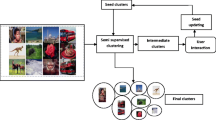Abstract
We introduce a new method for data clustering based on a particular Gaussian mixture model (GMM). Each cluster of data, modeled as a GMM into an input space, is interpreted as a hyperplane in a high dimensional mapping space where the underlying coefficients are found by solving a quadratic programming (QP) problem. The main contributions of this work are (1) an original probabilistic framework for GMM estimation based on QP which only requires finding the mixture parameters, (2) this QP is interpreted as the minimization of the pairwise correlations between cluster hyperplanes in a high dimensional space and (3) it is solved easily using a new decomposition algorithm involving trivial linear programming sub-problems. The validity of the method is demonstrated for clustering 2D toy examples as well as image databases.
Similar content being viewed by others
References
Bach FR, Jordan MI (2003) Learning spectral clustering. Neural information processing systems
Ben-Hur A, Horn D, Siegelmann HT, Vapnik V (2000) Support vector clustering. Neural information processing systems, pp 367–373
Bezdek JC (1981). Pattern recognition with fuzzy objective function algorithms. Plenum Press, New York
Bishop CM (1995). Neural networks for pattern recognition. Clarendon Press, Oxford
Carson C, Belongie S, Greenspan H and Malik J (2002). Blobworld: image segmentation using expectation-maximization and its application to image querying. IEEE Trans Pattern Anal Mach Intell 24(8): 1026–1038
Cristianini N and Shawe-Taylor J (2000). An introduction to support vector machines. Cambridge University Press, Cambridge
Dave RN (1991). Characterization and detection of noise in clustering. In Pattern Recognit 12(11): 657–664
Dempster A, Laird N and Rubin D (1977). Maximum likelihood from incomplete data via the em algorithm. J R Stat Soc B 39(1): 1–38
Fraley C (1998). Algorithms for model-based gaussian hierarchical clustering. SIAM J Sci Comput 20(1): 270–281
Frigui H, Krishnapuram R (1997) Clustering by competitive agglomeration. Pattern recognition, vol 30, no. 7
Frigui H and Krishnapuram R (1999). A robust competitive clustering algorithm with applications in computer vision. IEEE Trans Pattern Anal Mach Intell 21(5): 450–465
Halkidi M, Batistakis Y, Vazirgiannis M (2002) Cluster validity methods: Part i and ii. SIGMOD Record
Ichihashai H, Honda K, Tani N (2000) Gaussian mixture pdf approximation and fuzzy c-means clustering with entropy regularization. In: Proceedings of the 4th Asian fuzzy system symposium, pp 217–221
Jain AK and Dubes RC (1988). Algorithms for clustering data. Prentice Hall, Englewood Cliffs
Le-Saux B, Boujemaa N (2002) Unsupervised robust clustering for image database categorization. IEEE-IAPR International Conference on Pattern Recognition, pp 259–262
MacQueen J (1965) Some methods for classification and analysis of multivariate observations. In: Proceedings of the 5th Berkeley symposium on mathematical statistics and probability, vol 1
Orengo CA, Jones DT, Thornton JM (2003) Bioinformatics—genes, protein and computers. bios. ISBN: 1-85996-054-5
Osuna E, Freund R, Girosi F (1997) Training support vector machines: an application to face detection. In: Proceedings of the international conference on computer vision and pattern recognition, pp 130–136
Platt J (1999). Fast training of support vector machines using sequential minimal optimization. In: Schlkopf, B, Burges, C and Smola, AJ (eds) Advances in kernel methods—support vector learning, pp 185–208. MIT Press, Cambridge
Posse C (2001). Hierarchical model-based clustering for large datasets. J Comput Graph Stat 10(3): 464–486
Sahbi H, Boujemaa N (2005) Validity of fuzzy clustering using entropy regularization. In: proceedings of the IEEE conference on fuzzy systems
Sneath PH and Sokal RR (1973). Numerical taxonomy—the principles and practice of numerical classification. W. H. Freeman, San Francisco
Tanenbaum J, de Silva V and Langford J (2000). A global geometric framework for non-linear dimensionality reduction. Science 290(5500): 2319–2323
Tsao EK, Bezdek JC and Pal NR (1994). Fuzzy kohonen clustering networks. PR 27(5): 757–764
Vanderbei RJ (1999). LOQO: an interior point code for quadratic programming. Optim Methods Softw 11: 451–484
Wu M, Schoelkopf B (2006) A local learning approach for clustering. Advances neural information processing systems
Yang MS (1993). A survey of fuzzy clustering. MathCompMod 18: 1–16
Author information
Authors and Affiliations
Corresponding author
Rights and permissions
About this article
Cite this article
Sahbi, H. A particular Gaussian mixture model for clustering and its application to image retrieval. Soft Comput 12, 667–676 (2008). https://doi.org/10.1007/s00500-007-0247-y
Published:
Issue Date:
DOI: https://doi.org/10.1007/s00500-007-0247-y




